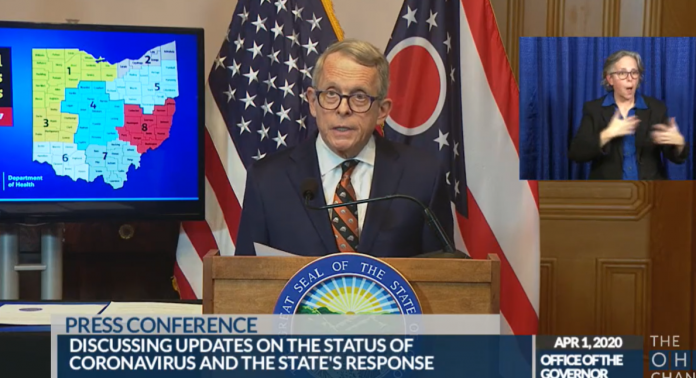The legislative effort to undermine Gov. Mike DeWine’s coronavirus pandemic response continues.
The latest example: a proposed “Restore Ohio Now” bill from Rep. Diane Grendell, R-Chesterland, that would end the COVID-19 State of Emergency in Ohio.
The State of Emergency was among the very first orders signed by the governor in addressing the virus. The emergency declaration was made on March 9, the same day that the first COVID-19 cases in Ohio were reported.
“This really allows us to do some things that we could not do without a State of Emergency,” DeWine said at that day’s press conference. “For example, it would allow us to purchase items, health-related items, without a bid.”
The order has remained in effect since then.
Grendell’s bill seeks not only to end the emergency order, but end any other order issued by DeWine that are contingent on the state of emergency.
One such example is the order limiting mass gatherings in Ohio, which was signed by then-Ohio Department of Health Director Dr. Amy Acton on March 12. That order states it remains in effect until the State of Emergency “no longer exists,” or is otherwise rescinded or modified.
“Many Ohioans have worked diligently, in good-faith with the Governor to flatten the curve of COVID-19 for months, and we accomplished this goal awhile back,” Grendell claimed in a statement in support for the bill.
Grendell said that DeWine initially responded “appropriately to an unknown threat facing Ohioans,” but has since continued to rely on “restrictive orders against our businesses and all Ohioans.”

R-Chesterland
Grendell and other House Republicans have introduced a number of bills this year seeking to curtail the executive power of the governor and state health director. They have characterized the executive branch as having overstepped its bounds in taking charge of the coronavirus response, with these bills presented as a way to ensure separation of powers.
“It’s crucial, for the sake of our people and our Constitution, that one branch of government cannot solely supersede on our entire state with overwhelming and unchecked authority,” Grendell continued in her statement.
Asked about the bill at his Sept. 17 press conference, DeWine said he had “a great deal of respect” for Grendell as a legislator but that he disagreed with this effort.
“I wish it was as simple as passing a law to get us away from an emergency that we’re in,” he said. “I mean, factually we are in an emergency whether it’s declared or not.
“Passing a law saying it’s not an emergency is not going to make it not an emergency,” the governor continued.
DeWine has threatened to veto bills that would curb his office’s power in handling the virus, though one recent bill signing was an exception. DeWine signed into law House Bill 272, which prohibits any public order to close places of worship and prevents a public official from intervening in an election being held, as the governor did with the March primary.
Churches in Ohio have never been forced to close during the pandemic. Some faith leaders have chosen to close or limit the number of worshipers in order to slow the spread, but there has never been a health order requiring them to do so. DeWine has defended this choice as allowing for First Amendment freedoms.
Grendell’s bill has not yet been formally introduced. She previously introduced the “Truth In COVID-19 Statistics” bill, looking to require the state health department to report certain pieces of information related to the virus. That bill passed the House but has not made progress in the Senate.
***
Also from Ohio Capital Journal:
DeWine: 70% of Ohioans in counties with increased COVID-19 spread
About 70 percent of Ohioans are living in a county with increased levels of COVID-19 exposure and spread, according to the state’s Public Health Advisory System.
While a few counties have receded from “red” status (“very high exposure and spread”), the system — based on a series of inputs like infection rates, emergency room and outpatient health visits — shows a virus slowly making its way into Ohio’s rural counties.
More than an abrupt boiling over, the PHAS depicts Ohio as a pot, gradually rising to a simmer.
“We just can’t seem to get the number of new cases down,” Gov. Mike DeWine said Thursday. “Really, what you’re seeing is the spread of the virus over the state.” READ MORE
National Guard assistance to foodbanks extended into December
Ohio’s volunteer-strapped foodbanks are getting help into December, the Ohio National Guard announced Thursday.
Demand for the services of food banks has jumped since the onset of the new coronavirus — especially since federal unemployment supplements expired on July 31.
Lisa Hamler-Fugitt, executive director of the Ohio Association of Foodbanks, has said a big challenge in meeting the increased demand has been getting volunteers to work at her association’s facilities. Many have stayed away out of health concerns, she said.
The Ohio National Guard has been helping to fill the void. But with federal funding on the wane, that assistance seemed poised to dry up. Then some rare good news came on Thursday.
“Federal funding for the National Guard response nationwide for COVID-19 missions has been extended into December,” the Guard said in a press release. “While there are Ohio National Guard units transitioning out of the foodbank mission in order to return to civilian and military obligations, new units are being brought in to continue to provide assistance at all 14 (food banks and warehouses) throughout the state.” READ MORE





